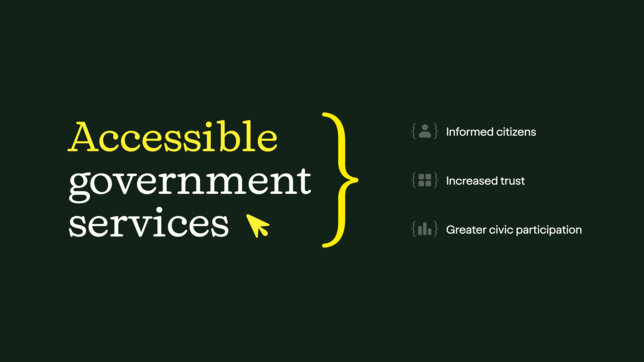
Kamil Tatol
-
Feb 09, 2024
-
3 min read
We live in an era dominated by digital transformation, and the public sector is slowly catching up with big companies, embracing various possibilities the digital world has to offer. Since the citizens are looking for better ways to take care of administrative tasks and their need for more efficient government services keeps growing, the e-government platforms need to be more citizen-centric. Yet, this change is happening gradually. Let’s delve into the prospering relationship between the public sector and the digital world, especially the imperative role of customer experience (CX) in this paradigm shift.
What is Customer Experience?
Before we explore the subject of Customer Experience in the public sector, we should define the following phrases:
- Customer Experience (CX) – this term refers to the quality of a user’s interaction with a digital product, including user satisfaction, accessibility, and efficiency.
- CX in the public sector – when discussing the public sector, CX is about the quality of a citizen’s interactions and engagement using e-government platforms.
- Public platform CX design – this term refers to the comprehensive approach to designing digital interfaces that enhance citizen experiences on government platforms. We talked more about CX design in our article “Customer experience design – what is it?”.
How does CX look on e-government platforms now?
The most important thing to remember while talking about CX in e-government platforms is that those platforms and their services differ depending on the country. However, the COVID-19 pandemic showed that most e-government platforms fell short of citizens’ expectations. They weren’t as easy to use or comprehensive as the citizens hoped.
During the pandemic, governments around the world began to prioritise online services. As a result, more countries decided to offer online services. In 2021, more than 90% of users in countries like Sweden, Denmark, and Finland used government websites for online processes. However, not all European countries followed suit. Romania, Bulgaria, and Italy had less than 50% of citizens engaging online with their governments.
So, what causes that difference? Or maybe – better yet – let’s rephrase this question…
Why does the CX matter in the public sector?
Online platforms and services, much like in the case of the private sector, allow governments to reconnect with people. When a government’s digital platform is intuitive, citizens are more likely to use it, increasing citizen engagement, trust, and satisfaction. When an e-government platform is designed poorly, the citizens are discouraged from interacting with it.
The World Government Summit published The Global Government Services Handbook 2023, highlighting the importance of shifting to the Customer-Centric Services Model. As they found out in their survey, only 56% of respondents from 29 countries found the overall quality of government services satisfactory; the frustrations users face included poor customer service, lack of information, long wait times to complete the process, and high service costs.
This means that in the public sector, citizens are not just users but stakeholders in the democratic process. A well-designed CX in public platforms goes far beyond user satisfaction. It makes government services more accessible and inclusive, fosters citizens’ trust, helps them become more informed, and encourages them to be more active.

So, to answer the question shortly, the CX in the public sector matters because it influences how the citizens perceive their governments and the connection the governments aim to have with their constituents in the digital realm.
How to design an excellent CX on public platforms?
An excellent Customer Experience on public platforms needs five things:
- user-centred design,
- accessibility features,
- personalization,
- clear communication,
- integration with other services.
As a digital consulting agency focusing on UX, we can’t stress enough the importance of focusing on the users and their needs. What does that mean? User research. We explained its importance in our article on UX research, but to put it simply and shortly, once you know what your users need, you can tailor your solutions to those who will be using them. That’s why it’s essential to understand the diverse demographics, accessibility requirements, and general needs of all citizens. For example, they can vary in terms of technological or digital knowledge. That’s also why most public platforms need intuitive navigation, compliance with WCAG (you can read more about it in our articles on digital accessibility and WCAG), and streamlined user journeys. Once those basics are covered, it’s also important to personalize the experience, e.g., based on the user history or preferences.
It’s also crucial to make the communication as clear as possible. Citizens of a country are usually a diverse group, and the content on public platforms should be understandable for everybody. This means writing clear instructions and explanations to avoid any confusion.
And last but not least – various government services should be integrated. If possible, on one platform or one system. If not, the e-government platforms should be integrated seamlessly to avoid confusion and frustration. A government can offer a variety of services online, from those for individuals (such as applying for identity documents) to those for businesses (such as registering a business). While they may be covered by separate ministries, there shouldn’t be much of a difference in design or the logic behind the processes. In other words, the user shouldn’t have to learn how to navigate an e-government platform more than once. A way to ensure that is to have a design system – a set of components that guarantees consistency across one or more digital products in terms of design patterns, reusable UI components, and guidelines on how to use them.
Summary
To answer the question from the title, “Why does Customer Experience matter in the public sector?”, I say it is because public platforms aim to have citizens engage with and appreciate digital government services. And the benefits of CX in the case of e-government platforms go beyond mere user satisfaction; a well-designed CX contributes to higher citizen engagement and operational efficiencies in the public sector. So, as the public sector continues its journey into the digital world, making CX a priority isn’t just a trend. It’s a necessity.








